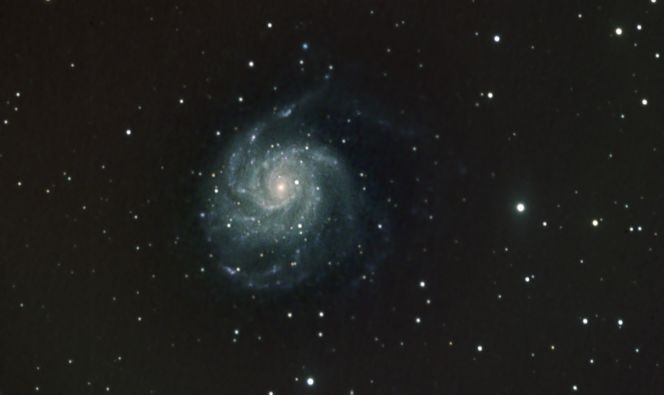
M101 is an impressive magnitude 7.9 face-on spiral galaxy in Ursa Major. Located about 3 degrees northeast of Zeta Ursae Majoris and about 3 degrees northwest of Eta Ursae Majoris, M101 forms an equilateral triangle with the last two stars in the handle of the Big Dipper asterism. M101 has well defined spiral arms, which are relatively tightly wound for a spiral galaxy. The central mass is dominated by a bright, nearly stellar nucleus. This galaxy is speeding away from us at a rate of about 245 miles per second. Some sources give a distance of about 15 million light-years for M101. The galaxy is 90,000 light-years across, making it one of the larger Sc type spiral galaxies. The total mass of all of the stars in M101 adds up to about 16 billion Suns. Since 1900, at least three supernovae have been recorded in M101.
M101 was discovered by P. Mechain in 1781, and described in the same year by Charles Messier as a "nebula without a star." Up until 1923 when Edwin Hubble conclusively proved otherwise, most people thought M101 and other galaxies were clouds of gas, or nebula, in our own Milky Way. However, to his credit, Admiral Smyth in 1844 described it as "one of those globular nebulae that seem to be caused by a vast agglomeration of stars." This galaxy is sometimes referred to as the Pinwheel Galaxy. M33 is also sometimes referred to as the Pinwheel Galaxy.
This is an RGB composite CCD image. An ST-8E CCD was used at prime focus on a Takahashi FCT-150 refractor with a reducer at f5.9. The optical tube assembly was carried on a Takahashi NJP mount.
M101 (NGC 5457)
Constellation: Ursa Major
RA: 14h 03m 12.4s Dec: +54d 21' 24"
January 17 & 18, 2005
Image by Sid Leach
Scottsdale, Arizona
Recent Images.
Complete list of images.
Description of equipment used to acquire images.
Home
Feedback and comments should go to Sid